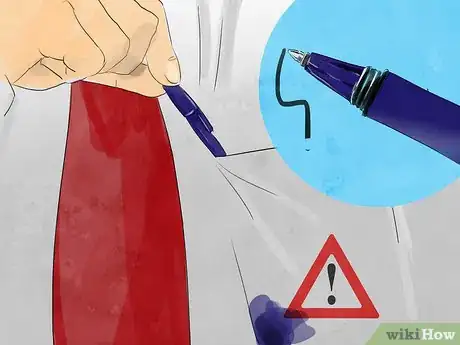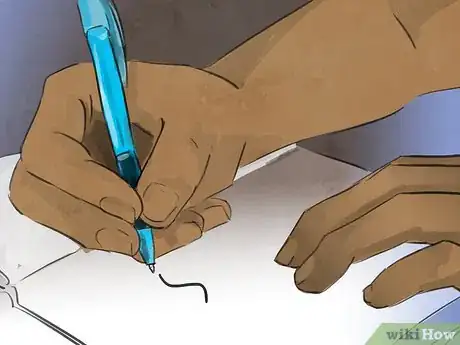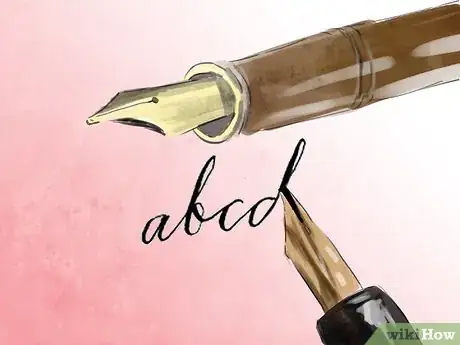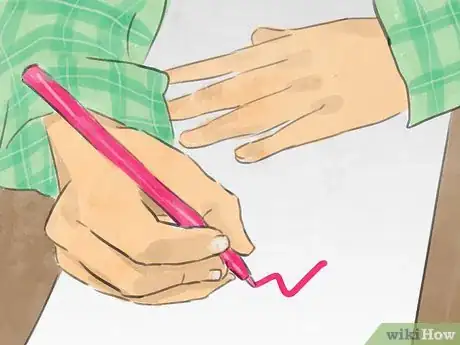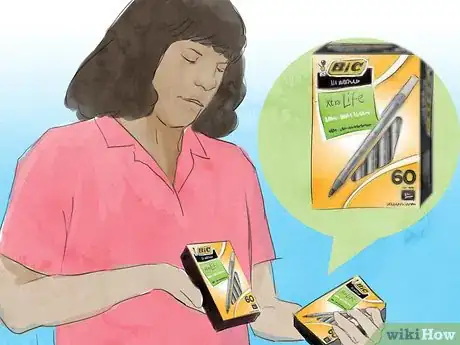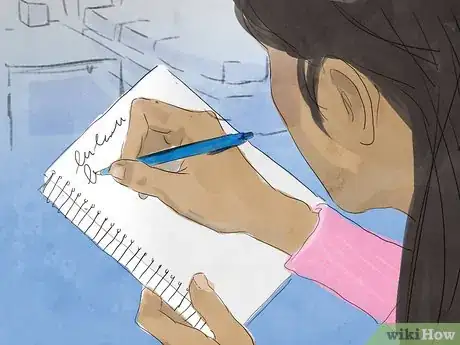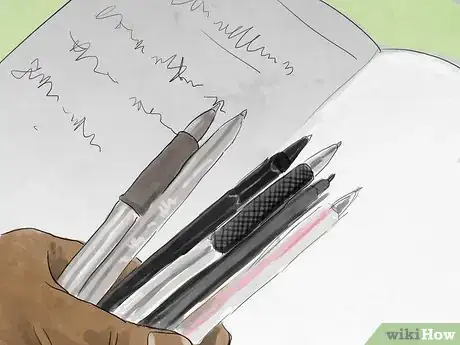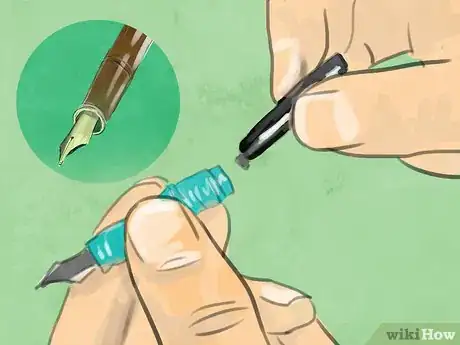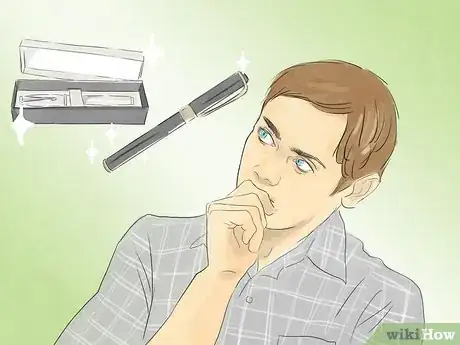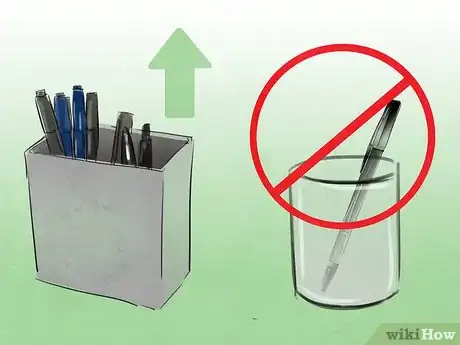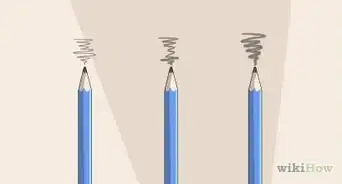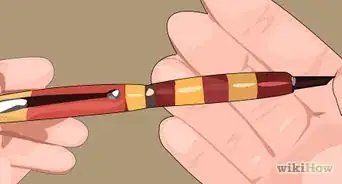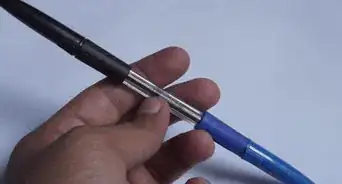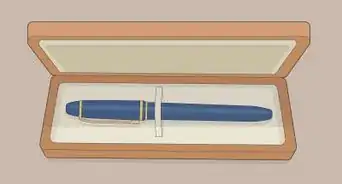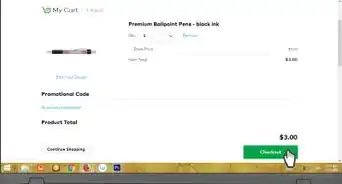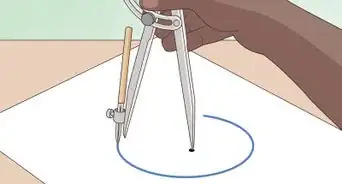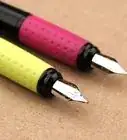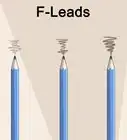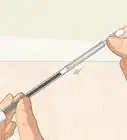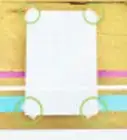This article was co-authored by wikiHow Staff. Our trained team of editors and researchers validate articles for accuracy and comprehensiveness. wikiHow's Content Management Team carefully monitors the work from our editorial staff to ensure that each article is backed by trusted research and meets our high quality standards.
There are 13 references cited in this article, which can be found at the bottom of the page.
wikiHow marks an article as reader-approved once it receives enough positive feedback. In this case, 83% of readers who voted found the article helpful, earning it our reader-approved status.
This article has been viewed 202,112 times.
Learn more...
If you write a lot, you know how important it is to choose the right pen for the job. But there are so many different sizes and shapes, not to mention all of the pen types, like rollerball, ballpoint, and fountain. So how do you pick the perfect pen for your unique writing needs? Luckily, we have all the info you need to decide in our guide to choosing the best pen.
Steps
Examining Different Types of Pens
-
1Use a ballpoint pen. Ballpoint pens are the most common variety you’re likely to find. They make use of a rounded tip that allows oil-based ink to go on smooth and dry quickly. Ballpoint pens are basic, inexpensive and easy to purchase in large quantities. For most purposes, a ballpoint pen will work just fine.[1]
- The best selling point of ballpoint pens is their low price. You can buy a large bag of disposable ballpoint pens for just a few dollars.
- The oil-based ink in ball point pens can congeal and collect dust over time, causing it form gummy globs around the tip.[2]
-
2Try a rollerball pen. Rollerball pens are similar to ballpoints, but the ink they deliver is water-based, so it transfers to the paper quickly and forms sharp, dark lines. These tend to be fitted with a smaller tip. Their liquid ink is stored in an internal reservoir. Many business professionals favor rollerball pens because they combine the thin lines and precision of a traditional fountain pen with the practicality of a ballpoint.[3]
- Having a finer tip produces thinner lines, which means your writing will look neater.
- Rollerball pens can leak easily when they’re put in your pocket, held upside down too long or exposed to changes in pressure. If you’re not careful, the ink might ruin your clothes.[4]
Advertisement -
3Write smoothly with a gel ink pen. Gel ink pens take their name from the thick fluid that they use to write. This type of ink creates extremely smooth, dark lines and allows for an even more effortless feel than ballpoint pens. Gel ink became popular as an alternative to scratchy, fine-tipped ink pens in the late 90s.[5]
- Gel ink pens are usually refillable, and tend to be slightly more expensive than garden variety ballpoint pens.
- One trade-off of gel inks ability to write in thick, smooth lines is that the ink dries very slowly. The gel sits on the surface of the paper momentarily before setting in. This makes it more likely to smudge and make a mess.[6]
-
4Learn to use a fountain pen. Fountain pens were among the first types of pens invented and are still considered by many to be the best. They are called “fountain” pens because of the way the ink flows from an internal storage reservoir out through the tip when you write. The ink used in a fountain pens is dark and dries quickly, and the lines they produce are the thinnest and longest-lasting.[7]
- Fountain pens are extremely customizable. They can be fitted with nibs (tips) of different thicknesses and refilled with inks of various colors. It’s also possible to vary the thickness of a line while writing with a fountain pen, as the shape of the nib allows for different angles of pressure.[8]
- The biggest disadvantage of using a fountain pen is their tendency to leak, due to the way the ink is stored and transferred. They can also be somewhat difficult to learn how to write with.
-
5Go bold with a felt tip. Felt tip pens ride the line between traditional ink pens and markers. They make use of a spongy fabric tip to deliver dark (and usually permanent) ink that sets into the paper very quickly. Their tips come in a couple different sizes, the thinnest of which is best suited for most writing tasks, while thicker tips are often used for art, construction and crafting projects where large, bold, legible writing is a necessity. The conical shape of the tip allows the writer to form thin lines using the point, or bold, tapering strokes by brushing with one side.[9]
- Felt tip pens may not be your go-to choice for a writing utensil, but they can come in handy if you're writing on an unusual surface or jotting down something you want to make sure will be seen.
- The watery ink in a felt tip pen has a tendency to run and bleed on thinner paper types. If you need to do some fine precision writing, such as signing your name, you may want to look elsewhere.
Picking the Right Pen for the Job
-
1Grab a bag of cheap, all-purpose pens. Sometimes you might opt for quantity over quality, especially if you only need a basic pen for occasional writing tasks. If this is the case, run down to your local convenience store and snag a package of non-refillable ballpoint pens for a couple bucks. You’ll have a supply that will get the job done and last you for months (or possible even years, assuming the ink doesn’t dry out), so you won’t have to worry about running out of pens for a long time.
- A package of 60 Bic Stic ballpoint pens can be purchased for less than $5. Inexpensive pens like this will be a no-brainer to people who aren’t looking to spend a lot on writing utensils.
- What these sort of pens lack in sophistication, they make up for in sheer availability.
-
2Find a pen that’s comfortable to use. If you do a lot of writing, make comfort a priority in picking the right pen for you. Many pen styles these days offer ergonomic designs and cushioned gripping surfaces. These features will be a benefit if you frequently spend hours signing, scribbling and outlining.[10]
- Try out different pens and see what feels the best. Pay attention to things like weight, the width of the body and how well it conforms to your hand.
- If you happen to use a pen you like while you’re out somewhere, make a note of what brand and model it is.
-
3Try out different pens to discover what type of ink you like best. Find an ink that looks good and serves your needs. People who like writing thick, smooth lines will do well with a quality ballpoint or gel ink pen. If you prefer the control and neat appearance of thin, sharp lines, go for a rollerball or fountain pen. Choosing an ink is mostly a matter of preference, as they each have distinct advantages and disadvantages.[11]
- The biggest factors in deciding on an ink are how smoothly it transfers to the writing surface, how bold the color is and how likely it is to run, smear or bleed.
-
4Choose between different pens based on their unique features. If you plan on using the pen for a specific purpose, such as signing your name legibly on important documents or inking a drawing, look for a pen that will best serve that purpose. Artists will want to use fountain pens, since they offer the widest range of nip sizes and can be filled with almost any type of ink. Scientists, executives and students will likely gravitate toward pens that are easy to carry and deliver ink efficiently. Those with arthritis might benefit from writing with wider pens that are less painful to grip.[12]
- People who are left handed should think about using pens that are filled with quick-drying inks, since they’ll be less prone to smudging if a hand is run over them.[13]
-
5Keep it simple with refillable pens. To spare yourself expense in the long run, give pens with refillable ink a shot. Fountain pens can be reloaded with various types of ink, and most fancier gel and ballpoint pens can be disassembled when you need to change out an old stick. It’s much cheaper to pick up some replacement ink sticks or cartridges than it is to buy brand new pens every time you run out.[14]
- Keep a stash of refill bottles, sticks or cartridges in your home, office or locker so that you’ll always have fresh ink when you need it.
- You can even get ink refills in unique colors, giving you the option of switching to blue, green, orange, purple or red ink if your work requires a lot of color-coding or you just get bored with plain black.
Having a Good Pen at the Ready
-
1Buy your favorite pens in bulk. Once you’ve found a pen you really like, get enough to last you awhile. Certain brands make their pens available by the bag, box or even case, perfect for people who are particular about what they use. Stockpiling pens will ensure that you have a constant supply, and save you the trouble of shopping for new pens regularly.
- Visit wholesale stores for deals on bulk packages of your favorite pens, or order them online.
- Older models of pens are frequently discontinued as new ones are released. If you’re partial to a particular pen, buy up as many as you can in case they disappear from the market later on.
-
2Invest in a premium pen and ink. Assuming you have a little money to spend, do some research on top-quality specialty pens. Companies like Platinum, Waterman and Montblanc manufacture pens using flawless designs and durable materials, so they’re guaranteed to last longer, leak less and always perform at peak level. If you weigh your options carefully, you might never have to buy another pen again.[15]
- Get a protective case to go along with an expensive pen to protect it from damage.
-
3Store and maintain your pens properly. No matter what kind of ink pen you end up going with, put it away somewhere room temperature and out of the way when you’re not using it. Store spares or refills together with your pens in the same drawer or in a nearby supply stash. Make sure the caps are secured and the pens are laid flat or arranged in an upright container to cut down on the chances of a leak.[16]
- Keep track of where you leave your pens so that you don’t lose them.
- Check your pockets for pens before you wash and dry them. Forgetting a pen when you do the laundry is a surefire way to ruin your clothes.
Community Q&A
-
QuestionWhat is the best pen for taking exams?
 Community AnswerAnything that shows up dark and legible. Professors tends to prefer that their students use black or blue ink, as it offers a contrast to the paper and is easier to read. Make sure you have a back up in case the pen you're using malfunctions runs out of ink.
Community AnswerAnything that shows up dark and legible. Professors tends to prefer that their students use black or blue ink, as it offers a contrast to the paper and is easier to read. Make sure you have a back up in case the pen you're using malfunctions runs out of ink. -
QuestionShould I use an erasable pen or whiteout when fixing a mistake?
 Community AnswerI would suggest whiteout since it's more versatile.
Community AnswerI would suggest whiteout since it's more versatile. -
QuestionWhat is the best pen to use for exams?
 Community AnswerI would suggest using a Bic crystal ball pen or round stick. Other pens, such as a fountain pen, will give you cramps or pain in your fingers if you are trying to write quickly for an exam. Bic ballpoint pens are efficient and cheap though.
Community AnswerI would suggest using a Bic crystal ball pen or round stick. Other pens, such as a fountain pen, will give you cramps or pain in your fingers if you are trying to write quickly for an exam. Bic ballpoint pens are efficient and cheap though.
Warnings
- Be careful not to lose the small pieces of refillable pens when you’re taking them apart.⧼thumbs_response⧽
- Writing on certain surfaces like flesh or damp correction fluid can disrupt a pen’s ability to properly dispense ink.⧼thumbs_response⧽
References
- ↑ https://www.pens.com/blog/choosing-the-write-pen-types/
- ↑ https://www.penchalet.com/blog/how-to-choose-a-pen/
- ↑ https://www.penchalet.com/blog/how-to-choose-a-pen/
- ↑ https://www.penheaven.co.uk/blog/rollerball-pens-vs-ballpoint-pens/
- ↑ https://www.penchalet.com/blog/how-to-choose-a-pen/
- ↑ https://www.gellyroll.com/history/
- ↑ http://www.levenger.com/ABOUT-LEVENGER-536/How-To-s-679/Maintaining-a-Fountain-Pen-1216.aspx
- ↑ http://www.jetpens.com/blog/guide-to-choosing-a-fountain-pen/pt/368
- ↑ http://www.jetpens.com/blog/guide-to-choosing-a-felt-tip-marker-pen/pt/666
- ↑ http://www.jetpens.com/blog/ergonomic-pens/pt/84
- ↑ https://www.ontimesupplies.com/community/kb/office-supplies-guides/how-to-choose-pens-and-ink.html
- ↑ https://www.penchalet.com/blog/how-to-choose-a-pen/
- ↑ http://www.thecramped.com/fountain-pen-guide-for-the-left-handed-writer/
- ↑ https://www.greenlivingtips.com/articles/refillable-vs-disposable-pens.html
- ↑ http://www.bestfountainpen.com/best-fountain-pens-under-400/
- ↑ http://www.wellappointeddesk.com/2013/07/ask-the-desk-storing-pens-up-or-down/
About This Article
To choose a pen, start by holding a bunch of different ones to see what feels good. Pay attention to each pen’s weight and body width, and make notes on what’s most comfortable. Then try writing with the pens and see what kind of ink you like. Do you like the look and feel of a rollerball’s thin, sharp lines or a gel pen’s thick, dark ink? You may prefer one type of pen for signing your name and another for drawing or writing thank-you notes. Feel free to pick several pens, matching your pen to your purpose. If you want to learn more, such as how to store your pens after you get them, keep reading the article!

